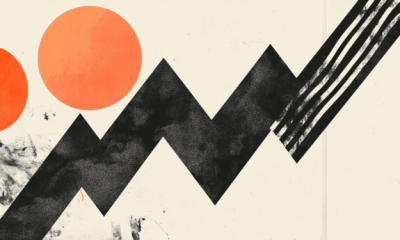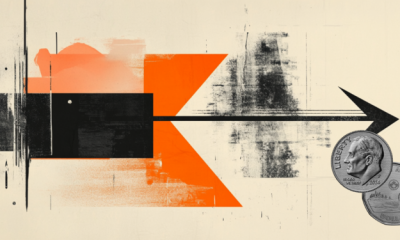

others
Bank of Canada looks set to hold interest rates despite cooling inflation – Crypto News
- The Bank of Canada (BoC) is expected to keep its rates unchanged.
- The Canadian Dollar has met a tough resistance at around 1.3600.
- Canadian inflation remains sticky, although on a downward path.
There is widespread expectation that the Bank of Canada (BoC) will keep its policy rate steady at 5.0% for the fifth consecutive time during its upcoming policy meeting on Wednesday. The Canadian Dollar (CAD) has experienced significant depreciation against the US Dollar (USD) since the start of the new year, following a sharp rise from its November lows around 1.3900. This week, USD/CAD has maintained a consolidative theme in the upper end of the range, in line with the rest of the FX universe.
Headline inflation, tracked by the Consumer Price Index (CPI), kept its downtrend in the first month of the year even as the BOC’s Core CPI showed signs of sticky price pressures. In this context, the central bank is predicted to deliver a prudent approach, highlighting the need to assess further incoming data as well as their sustainability before deciding on any move on rates, namely the start of the easing cycle. This last view matches that of most of the bank’s G10 peers (the Federal Reserve, ECB, Bank of England, and Reserve Bank of Australia).
A hint of caution looms
Since its January gathering, the BoC is expected to maintain a conservative outlook on GDP growth. Back to that meeting, the bank anticipated a growth rate of 0.8% this year and 2.4% in 2025, aligning with their previous forecast released in October.
Regarding inflation, Governor Tiff Macklem said at his press conference in January that the surge in shelter prices is the primary driver of inflation exceeding the target, adding that the journey towards achieving 2% inflation is expected to be gradual with lingering risks. He argued that the policy interest rate of 5% is deemed necessary to further subdue inflationary pressures, while the focus of discussions regarding future policy is shifting from whether monetary policy is sufficiently restrictive to how long the current stance should be maintained.
From the latest news, fifteen out of twenty economists warned that there is a higher likelihood of the first rate cut by the Bank of Canada occurring later than initially predicted rather than sooner. Additionally, nineteen out of thirty-one economists anticipate that the Bank of Canada will reduce the overnight rate from 5.00% to 4.75% in June.
According to analysts at TD Securities: “We look for the BoC to stick to the recent script as it holds the overnight rate at 5.00% and continues to seek more evidence that inflation is on track for a sustained return to 2%. We look for the overall message to remain one of cautious optimism, and while the January CPI report skews risks towards a more dovish outcome, we do not expect the Bank will overreact to a single data point.”
When will the BoC release its monetary policy decision and how could it affect USD/CAD?
The Bank of Canada will announce its policy decision at 14:45 GMT on Wednesday, followed by the usual press conference by Governor Macklem at 15:30 GMT.
Banning surprises, any anticipated effect on the Canadian currency is expected to be minimal, if any. A cautious decision to maintain current conditions might lead to a short-term, reflexive decline in USD/CAD, although its duration and magnitude are unlikely to be significant. It’s worth noting that much of the upward movement in the spot rate so far this year is attributed to the dynamics of the USD.
According to Pablo Piovano, Senior Analyst at FXStreet.com, “the gradual uptrend in USD/CAD in place since the beginning of the year appears reinforced by the recent surpass of the key 200-day SMA at 1.3479. However, this trend has so far met quite a decent barrier at the 1.3600 neighbourhood. A sustainable break above this region could motivate the pair to set sails to the November 2023 peak of 1.3898 (November 1).”
Piovano adds: “If sellers regain the upper hand, the 55-day SMA at 1.3428 should offer temporary contention prior to the weekly low of 1.3358 (January 31). Extra weakness from here could open the door to a move to the December 2023 bottom of 1.3177 (December 27).”
Economic Indicator
Canada BoC Press Conference
After Bank of Canada (BoC) meetings and the release of the Monetary Policy Report, the BoC Governor and Senior Deputy Governor hold a press conference at which they field questions from the media. The press conference has two parts – first a prepared statement is read out, then the conference is open to questions from the press. Hawkish comments tend to boost the Canadian Dollar (CAD), while a dovish message tends to weaken it.
Bank of Canada FAQs
The Bank of Canada (BoC), based in Ottawa, is the institution that sets interest rates and manages monetary policy for Canada. It does so at eight scheduled meetings a year and ad hoc emergency meetings that are held as required. The BoC primary mandate is to maintain price stability, which means keeping inflation at between 1-3%. Its main tool for achieving this is by raising or lowering interest rates. Relatively high interest rates will usually result in a stronger Canadian Dollar (CAD) and vice versa. Other tools used include quantitative easing and tightening.
In extreme situations, the Bank of Canada can enact a policy tool called Quantitative Easing. QE is the process by which the BoC prints Canadian Dollars for the purpose of buying assets – usually government or corporate bonds – from financial institutions. QE usually results in a weaker CAD. QE is a last resort when simply lowering interest rates is unlikely to achieve the objective of price stability. The Bank of Canada used the measure during the Great Financial Crisis of 2009-11 when credit froze after banks lost faith in each other’s ability to repay debts.
Quantitative tightening (QT) is the reverse of QE. It is undertaken after QE when an economic recovery is underway and inflation starts rising. Whilst in QE the Bank of Canada purchases government and corporate bonds from financial institutions to provide them with liquidity, in QT the BoC stops buying more assets, and stops reinvesting the principal maturing on the bonds it already holds. It is usually positive (or bullish) for the Canadian Dollar.
-
others1 week ago
Ex‑FSL Leader Launches TrendsDotFun to Tokenize Social Media Posts – Crypto News
-

 Technology5 days ago
Technology5 days agoBest 5G phones under ₹10,000 in July 2025: Infinix Hot 60, Samsung M06 and more – Crypto News
-
Technology1 week ago
Bitwise Crypto Index Fund Holding BTC, ETH, XRP To Convert Into ETF – Crypto News
-

 Cryptocurrency7 days ago
Cryptocurrency7 days agoETH to Lead BTC Over Next 6 Months, Says Galaxy CEO – Crypto News
-
Technology6 days ago
Why is Shiba Inu Price Up Today? – Crypto News
-

 Cryptocurrency1 week ago
Cryptocurrency1 week agoMassive Polkadot (DOT) Rally Ahead? Here’s What’s Driving It – Crypto News
-
Cryptocurrency1 week ago
Scaling the Future: Bitcoin.ℏ’s 10,000 TPS Advantage with Hedera Hashgraph – Crypto News
-

 Technology1 week ago
Technology1 week agoAlibaba launches its ‘most advanced’ open-source AI model Qwen3-Coder — All you need to know – Crypto News
-

 others6 days ago
others6 days agoArthur Hayes-Backed Altcoin Outpaces Crypto Market Amid Launch of New Partnership With Anchorage Digital – Crypto News
-
others5 days ago
Japan CFTC JPY NC Net Positions rose from previous ¥103.6K to ¥106.6K – Crypto News
-

 Blockchain5 days ago
Blockchain5 days agoTether Gold (XAUt) Market Cap Soars as Gold Hits Record Highs in 2025 – Crypto News
-

 Cryptocurrency7 days ago
Cryptocurrency7 days agoETH to Lead BTC Over Next 6 Months, Says Galaxy CEO – Crypto News
-

 others6 days ago
others6 days agoUS Dollar finds support amid Fed uncertainty and tariff talks – Crypto News
-

 Technology6 days ago
Technology6 days ago‘Screwed up’: Sam Altman warns against using ChatGPT as your lawyer or therapist – Crypto News
-

 Technology5 days ago
Technology5 days agoWho is Shengjia Zhao? ChatGPT co-creator named Chief Scientist at Meta’s Superintelligence Labs – Crypto News
-

 De-fi1 week ago
De-fi1 week agoCrypto Markets Wobble as Fed Chair Powell Faces Pressure – Crypto News
-

 De-fi1 week ago
De-fi1 week agoCrypto Markets Wobble as Fed Chair Powell Faces Pressure – Crypto News
-

 Cryptocurrency5 days ago
Cryptocurrency5 days agoMarket update: Bitcoin rises after US-EU announce framework trade agreement – Crypto News
-

 Cryptocurrency4 days ago
Cryptocurrency4 days agoBitcoin and Ethereum ETFs Pull in Record-High $11.2 Billion in July – Crypto News
-

 De-fi1 week ago
De-fi1 week agoTrump Media Amasses $2 Billion Bitcoin Hoard After SEC-Cleared Fundraise – Crypto News
-

 Cryptocurrency1 week ago
Cryptocurrency1 week agoEthereum price forecast as ETH dominance jumps to 11.5% – Crypto News
-

 De-fi1 week ago
De-fi1 week agoStablecoin Flows are Directly Impacting Treasury Yields: Messari – Crypto News
-
Business1 week ago
Why is PENGU Price up today? – Crypto News
-

 Cryptocurrency7 days ago
Cryptocurrency7 days agoFriday charts: Crazy train investing – Crypto News
-

 Metaverse7 days ago
Metaverse7 days agoHow AI can weave a future for Kashmir’s centuries old carpet industry – Crypto News
-
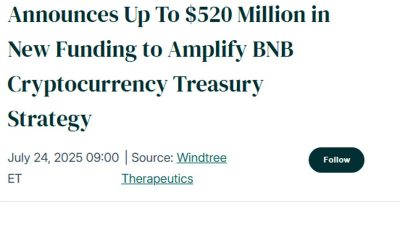
 De-fi6 days ago
De-fi6 days agoWindtree Therapeutics Plans $520 Million Raise, 99% for BNB, Secures $500M Equity Line, Uses Kraken Custody – Crypto News
-
Business6 days ago
Buy DexScreener Reactions – Boost Legends: Guide + $5 Bonus – Crypto News
-

 De-fi5 days ago
De-fi5 days agoETH Unstaking Queue Hits Record High, Led by Justin Sun-Linked Addresses – Crypto News
-
others4 days ago
‘Sit Tight With Bitcoin’ Robert Kiyosaki Predicts Great Depression 2.0 – Crypto News
-
Technology4 days ago
Solayer Launches USDC-Powered Hotel Booking Platform To Give Crypto Travel a Boost – Crypto News
-
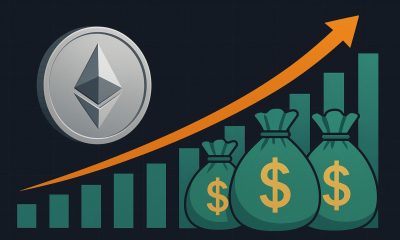
 Blockchain1 week ago
Blockchain1 week agoEthereum Big-Money Flow Hits 3-Year High With $100B In Weekly Volume – Crypto News
-
Cryptocurrency1 week ago
Crypto ETFs May Soon Have In-Kind Feature As Five Issuers File Amendments – Crypto News
-
Business1 week ago
Solana Price Flashes Golden Cross as Staked SOL ETF Hits Key Milestone- Is $294 Next? – Crypto News
-
Business1 week ago
Fact Check: Did Jerome Powell Resign As Fed Chair? – Crypto News
-
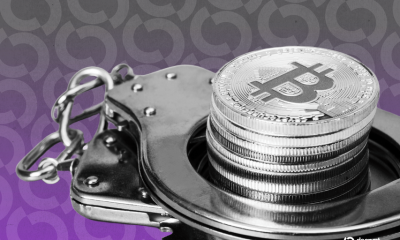
 Cryptocurrency1 week ago
Cryptocurrency1 week agoDenver Pastor, Wife Indicted in Alleged $3.4 Million Crypto Scam – Crypto News
-

 others1 week ago
others1 week agoUSD/INR refreshes monthly high on relentless FIIs sell-off in Indian equities – Crypto News
-
Business1 week ago
Crypto Market Crashes Amid Trump’s Threat to Increase Tariffs – Crypto News
-

 Blockchain1 week ago
Blockchain1 week agoBNY, Goldman Launch Blockchain Solution – Crypto News
-

 De-fi1 week ago
De-fi1 week agoGoldman Sachs, BNY to Launch Tokenized Money Market Fund – Crypto News
-

 De-fi5 days ago
De-fi5 days agoBank of America Says U.S. Lenders Ready Stablecoin Launches – Crypto News
-
Business4 days ago
Ethereum Breaks $3,900 as SharpLink Makes Another $295M ETH Purchase – Crypto News
-

 Cryptocurrency4 days ago
Cryptocurrency4 days agoZK breakthroughs, onchain comebacks and stablecoin shakeups – Crypto News
-
Business4 days ago
Breaking: US SEC Delays Launch Of Truth Social’s Bitcoin ETF And Grayscale’s Solana ETF – Crypto News
-
Technology4 days ago
Just In: $111B Brokerage Giant Interactive Brokers Explores Stablecoin for Funding – Crypto News
-
others4 days ago
Breaking: PayPal to Let Merchants Accept Payments in Over 100 Cryptocurrencies – Crypto News
-

 Technology3 days ago
Technology3 days agoSpotify hits 276M subscribers and strong user growth in Q2, but revenue and profit fall short of targets – Crypto News
-
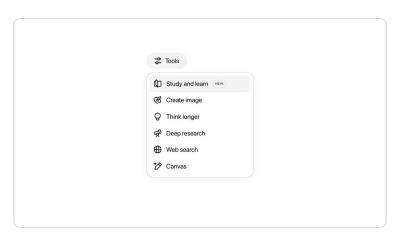
 Metaverse3 days ago
Metaverse3 days agoOpenAI rolls out ‘Study Mode’ in ChatGPT: What is it? How to use? All your questions answered… – Crypto News
-

 De-fi1 week ago
De-fi1 week agoAavegotchi Holders Push Back Against $3.2 Million Buyout Bid from Chinese VC – Crypto News
-
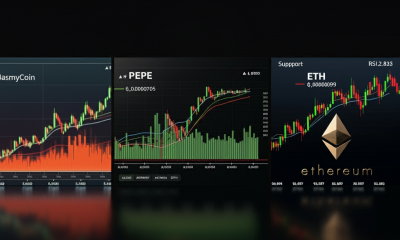
 Cryptocurrency1 week ago
Cryptocurrency1 week agoHow to Invest in Cryptocurrency In India – Crypto News
-
others1 week ago
Court Approves $1.9B Reserve Release, Enabling Next FTX Distribution – Crypto News



